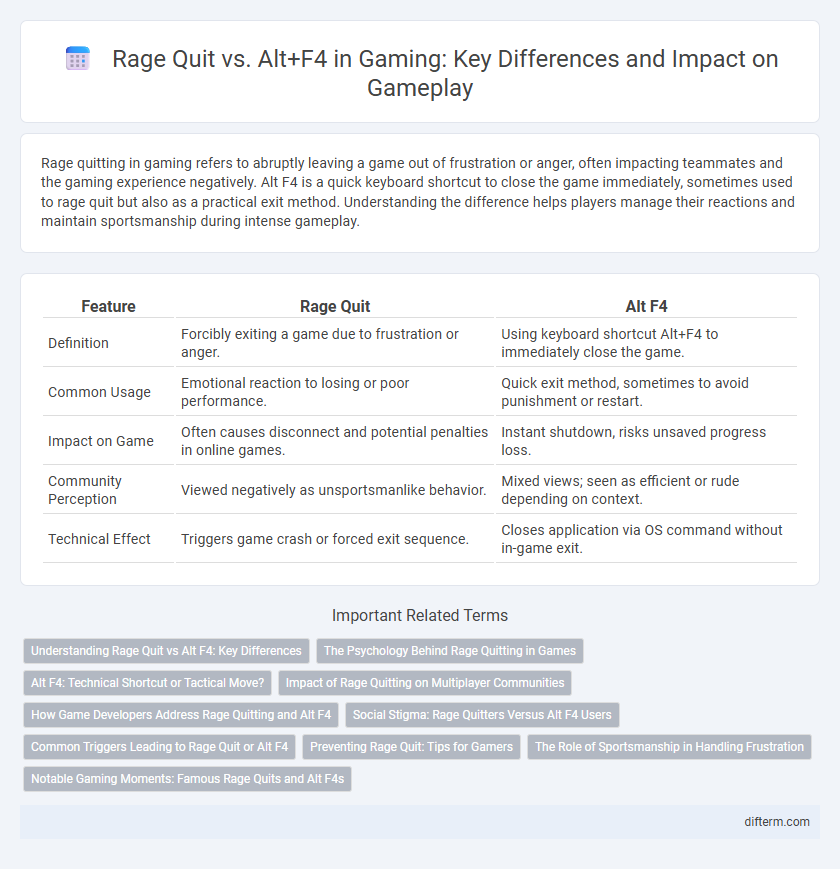Rage quitting in gaming refers to abruptly leaving a game out of frustration or anger, often impacting teammates and the gaming experience negatively. Alt F4 is a quick keyboard shortcut to close the game immediately, sometimes used to rage quit but also as a practical exit method. Understanding the difference helps players manage their reactions and maintain sportsmanship during intense gameplay.
Table of Comparison
| Feature | Rage Quit | Alt F4 |
|---|---|---|
| Definition | Forcibly exiting a game due to frustration or anger. | Using keyboard shortcut Alt+F4 to immediately close the game. |
| Common Usage | Emotional reaction to losing or poor performance. | Quick exit method, sometimes to avoid punishment or restart. |
| Impact on Game | Often causes disconnect and potential penalties in online games. | Instant shutdown, risks unsaved progress loss. |
| Community Perception | Viewed negatively as unsportsmanlike behavior. | Mixed views; seen as efficient or rude depending on context. |
| Technical Effect | Triggers game crash or forced exit sequence. | Closes application via OS command without in-game exit. |
Understanding Rage Quit vs Alt F4: Key Differences
Rage quitting in gaming refers to abruptly leaving a match or session due to frustration or anger, often without warning, impacting team dynamics and player reputation. Alt F4 is a specific keyboard shortcut used to forcibly close the game window immediately, which can be a method of rage quitting but lacks the emotional context and intent behind rage quitting behavior. Understanding the difference lies in recognizing rage quit as an emotional response affecting gameplay and social interaction, whereas Alt F4 is simply a technical action that may or may not carry emotional intent.
The Psychology Behind Rage Quitting in Games
Rage quitting in games is driven by intense frustration and perceived unfairness, triggering fight-or-flight responses that lead players to abruptly exit sessions to protect self-esteem. This emotional reaction contrasts with the more calculated use of Alt F4, which is often employed to avoid penalties or disconnect cleanly without losing progress. Understanding these psychological mechanisms reveals how players' stress levels and coping strategies influence their in-game quitting behavior and overall gaming experience.
Alt F4: Technical Shortcut or Tactical Move?
Alt F4 serves as a technical shortcut designed to instantly close the active game window, providing a swift escape from frustrating gaming moments without navigating menus. While often perceived as a tactical move to abruptly exit multiplayer sessions, its primary function remains rooted in Windows OS commands rather than intentional gameplay strategy. Understanding Alt F4's role highlights the distinction between user-induced disconnections and technical shortcuts within the gaming community.
Impact of Rage Quitting on Multiplayer Communities
Rage quitting disrupts multiplayer communities by causing unfair game imbalances and frustrating teammates, often leading to decreased player retention and community trust. Unlike the cleaner exit of Alt F4, rage quitting signals emotional volatility that can foster toxic environments and discourage cooperative gameplay. Persistent rage quitting undermines the social cohesion essential for competitive and cooperative online gaming experiences.
How Game Developers Address Rage Quitting and Alt F4
Game developers implement anti-rage quit measures such as penalty systems, matchmaking adjustments, and real-time behavior analytics to discourage abrupt game exits and maintain fair play. Many studios deploy server-side detection to flag Alt F4 usage, mitigating exploitative disconnects that disrupt multiplayer balance. Continuous updates integrate machine learning to refine detection algorithms, promoting accountability and enhancing player experience by minimizing the impact of rage quitting and Alt F4 tactics.
Social Stigma: Rage Quitters Versus Alt F4 Users
Rage quitters face stronger social stigma in gaming communities due to their visible emotional outbursts and abrupt exits during matches, often perceived as unsportsmanlike and disrespectful to teammates. Alt F4 users, who silently close the game to avoid immediate defeat, encounter less criticism but are sometimes labeled as cowards or passive losers. The distinction in social stigma highlights community preferences for transparent, accountable behavior over evasive tactics in competitive gaming environments.
Common Triggers Leading to Rage Quit or Alt F4
Common triggers leading to rage quit or Alt F4 in gaming include persistent in-game failures, such as repeated deaths or losing streaks, which escalate frustration and prompt players to exit abruptly. Technical issues like lag, glitches, or server disconnections disrupt gameplay flow and often provoke immediate quits to avoid further irritation. Competitive pressure and toxic player interactions also significantly contribute to rage quitting behavior, driving users to close games prematurely to escape negative experiences.
Preventing Rage Quit: Tips for Gamers
Preventing rage quits enhances gaming experiences by maintaining player focus and reducing frustration through effective stress management techniques such as deep breathing and short breaks. Setting realistic in-game goals and gradually increasing difficulty can help gamers maintain motivation and avoid impulsive exits. Utilizing game features like saved progress and customizable controls also supports sustained engagement and minimizes the urge to abruptly quit.
The Role of Sportsmanship in Handling Frustration
Rage quitting and pressing Alt F4 both reflect poor sportsmanship, showing a lack of respect for the game and other players. Maintaining composure and demonstrating good sportsmanship fosters a positive gaming culture, reduces toxic behavior, and enhances overall player experience. Professional gamers and esports communities emphasize patience and resilience as key elements in handling frustration constructively.
Notable Gaming Moments: Famous Rage Quits and Alt F4s
Famous rage quits and Alt F4 moments have become iconic in gaming history, showcasing intense player frustration and viral reactions. Notable examples include popular streamers abruptly exiting competitive matches like Ninja's furious exit during a high-stakes Fortnite game and Shroud's Alt F4 after a critical defeat in CS:GO. These incidents highlight the emotional stakes in esports and often spark community debates about sportsmanship and mental resilience in gaming culture.
Rage Quit vs Alt F4 Infographic

 difterm.com
difterm.com